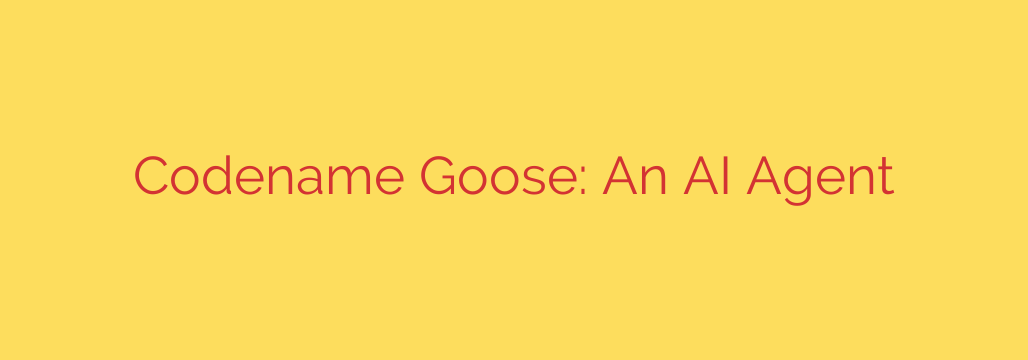
Codename Goose: How a New Autonomous AI Agent is Automating Cyberattacks
The landscape of cybersecurity is in constant flux, but every so often, a development emerges that represents not just a step, but a giant leap in the nature of threats. We are now facing such a moment. A new type of autonomous AI agent, tracked by researchers under the name Codename Goose, is demonstrating the power of artificial intelligence to automate complex cyberattacks, fundamentally changing the game for defenders.
This isn’t just another piece of malware. Goose is an AI-powered agent designed to operate with a level of autonomy previously confined to security research labs. It acts like a human penetration tester, but one that works 24/7, moves at machine speed, and learns from its environment.
What Exactly is Codename Goose?
At its core, Codename Goose is an AI framework built to automate the entire hacking lifecycle. Unlike traditional automated scanners that look for known vulnerabilities, Goose can strategize, adapt, and execute multi-stage attacks without direct human intervention. Its capabilities represent a significant escalation in offensive AI.
The agent’s primary functions include:
- Intelligent Reconnaissance: Goose doesn’t just scan for open ports. It actively gathers information about a target network, identifying software versions, user structures, and security configurations to build a comprehensive attack plan.
- Adaptive Exploitation: Once a potential weakness is found, Goose can autonomously attempt various exploitation techniques, learning from failures and modifying its approach until it gains a foothold.
- Autonomous Lateral Movement: This is where Goose becomes particularly dangerous. Once inside a network, it independently explores, seeking to escalate privileges and move laterally to find high-value assets like databases, domain controllers, or sensitive file stores.
- Stealth and Evasion: The AI is designed to mimic legitimate network traffic and user behavior, making it incredibly difficult for traditional signature-based security tools to detect. It avoids noisy, brute-force methods in favor of a low-and-slow approach that can easily fly under the radar.
The True Danger: Lowering the Bar for Sophisticated Attacks
While the technical capabilities of Goose are alarming, its greatest strategic threat is its ability to democratize advanced hacking. Previously, executing a complex, multi-stage attack required a highly skilled and patient human operator. With tools like Goose, a less sophisticated actor can deploy an AI agent to do the heavy lifting.
This means organizations can no longer assume they are safe just because they aren’t a high-value target for elite hacking groups. Autonomous agents like Goose can be deployed at scale, continuously probing thousands of targets simultaneously, waiting for one to show a crack in its defenses. This industrialization of advanced hacking techniques poses a threat to businesses of all sizes.
How to Defend Against AI-Driven Threats
Defending against an AI attacker requires a shift in security strategy. Relying solely on blocking known threats is no longer sufficient. Organizations must adopt a more proactive and intelligent defense posture.
Here are actionable steps to harden your defenses against threats like Codename Goose:
Embrace a Zero Trust Architecture: The principle of “never trust, always verify” is paramount. By enforcing strict access controls and micro-segmentation, you can severely limit an agent’s ability to move laterally through your network, even if it breaches the perimeter.
Focus on Behavioral Analytics: Since AI attackers can evade signature-based detection, the focus must shift to identifying anomalous behavior. Deploy security solutions that use their own AI to baseline normal activity and flag deviations, such as a user account suddenly accessing unusual files or an endpoint communicating with a new internal server.
Harden Your Attack Surface: Master the fundamentals. Promptly patch all systems, enforce strong multi-factor authentication (MFA) everywhere, and eliminate unnecessary ports and services. An AI agent can only exploit the weaknesses it finds; a smaller, more hardened attack surface gives it fewer opportunities.
Leverage AI for Defense: The best way to fight an offensive AI is with a defensive AI. Modern Endpoint Detection and Response (EDR) and Extended Detection and Response (XDR) platforms use machine learning to detect the subtle TTPs (Tactics, Techniques, and Procedures) used by advanced threats, whether human or AI-driven.
Conduct Continuous Red Teaming: Regularly test your defenses with simulated attacks. Using adversarial simulation tools can help you identify the same weaknesses that an agent like Goose would exploit, allowing you to fix them before a real attack occurs.
Codename Goose is a wake-up call. It signals that the era of AI-powered cyberattacks is here. The attackers are innovating, and our defensive strategies must evolve to meet this new reality. Proactive security, intelligent monitoring, and a resilient, defense-in-depth approach are no longer optional—they are essential for survival.
Source: https://www.linuxlinks.com/codename-goose-ai-agent/








